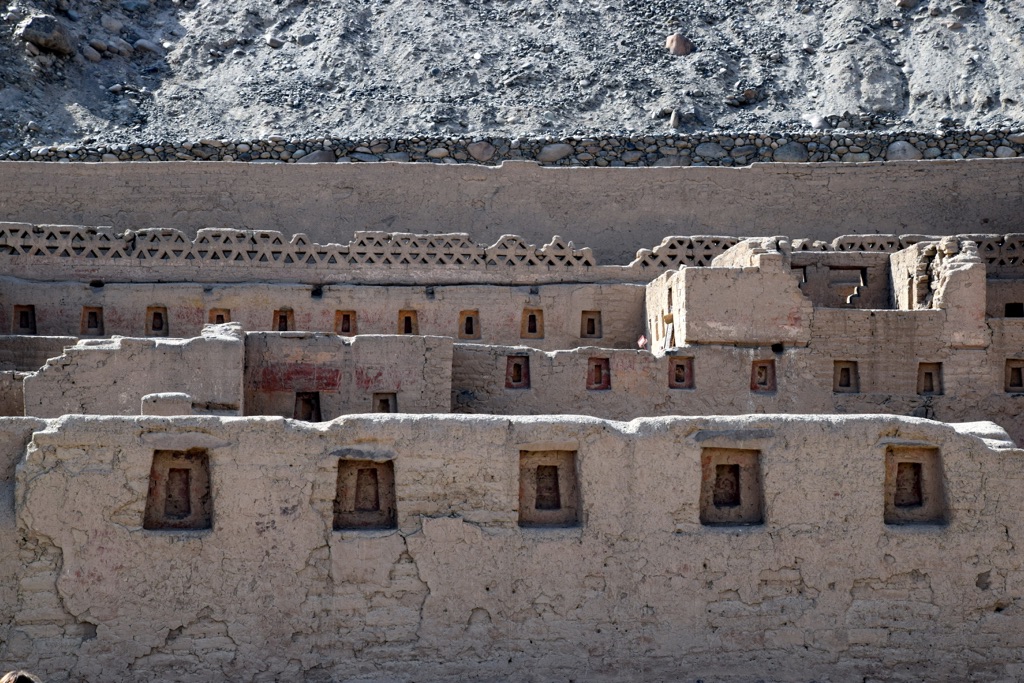Tambo Colorado is a well-preserved Inca archaeological site in Peru. It’s known for its unique adobe construction and vibrant wall paintings. The site served as an administrative center, showcasing the Inca’s sophisticated urban planning and architectural skills. Tambo Colorado provides a window into the Inca civilization’s way of life before the Spanish conquest.
Get your dose of History via Email
Historical Background of Tambo Colorado
The discovery of Tambo Colorado dates back to the 19th century. Notably, the explorer Antonio Raimondi stumbled upon it during his travels across Peru. The Inca Empire, under the rule of Pachacuti and his successors, built this site. It served as a strategic rest stop for travelers and a regional administrative center. Later inhabitants left few traces, preserving the site’s Inca origins. Tambo Colorado stands as a silent witness to the Inca’s expansive and well-organized empire.
The Inca built Tambo Colorado in the late 15th century. It was during the height of their civilization’s power. The site’s strategic location along Inca roads facilitated control over the surrounding territory. It also allowed for efficient communication across the empire. The Inca’s engineering prowess is evident in the site’s complex design and construction.
After the Spanish conquest, Tambo Colorado’s significance waned. It did not see major battles or events. However, its preservation allows historians to study Inca civil administration and cultural practices. The site’s name, meaning “red resting place,” comes from the red pigment found on its walls. This pigment is a testament to the Inca’s use of color in architecture.
Tambo Colorado’s historical importance lies in its state of preservation. It offers insights into Inca urban planning and architecture. The site’s layout includes a central plaza, residential quarters, and storage facilities. These elements reflect the Inca’s sophisticated societal structure. The site’s preservation has made it a focal point for archaeological study and conservation efforts.
The site has not been the scene of significant historical events since its construction. Yet, it remains an important cultural landmark. It provides a tangible connection to the Inca Empire’s past. Tambo Colorado’s preservation allows for ongoing research and education. It helps us understand the complexities of pre-Columbian civilizations in South America.
About Tambo Colorado
Tambo Colorado stands out for its adobe brick construction. This material choice is unusual for Inca architecture, which typically features stone. The site includes several structures, such as a main plaza, ceremonial platforms, and living quarters. These buildings are arranged around a central axis, showcasing the Inca’s planning skills.
The buildings at Tambo Colorado feature high walls and trapezoidal doorways. These are characteristic of Inca design. The use of adobe allowed for faster construction compared to stone. It also provided insulation from the harsh desert climate. The site’s layout reflects a hierarchical society, with areas designated for elites and commoners.
One of the most striking features of Tambo Colorado is its colorful wall paintings. The pigments used have withstood the test of time, hinting at the Inca’s advanced techniques. The colors include shades of red, yellow, white, and black. These were likely derived from natural minerals and plants.
The site’s main complex, known as the “palace,” is a large rectangular building. It has several rooms and an open courtyard. The architectural highlights include niches in the walls and a sophisticated drainage system. These features demonstrate the Inca’s understanding of their environment and their ability to adapt their construction techniques accordingly.
Tambo Colorado’s construction methods and materials provide a contrast to other Inca sites. It offers a unique perspective on the diversity of Inca architecture. The site’s preservation has made it a valuable resource for understanding Inca building practices and their adaptation to different environments.
Theories and Interpretations
Several theories exist about Tambo Colorado’s purpose. Most agree it functioned as an administrative center. It may have also served as a military outpost or a ceremonial site. The presence of kallankas, large communal halls, supports the idea of its administrative use.
The mystery of Tambo Colorado lies in its unique adobe construction. This has led some to speculate about the influence of other cultures on the Inca. The site’s location in a coastal desert region may have necessitated the use of adobe. This material was more readily available than stone.
Interpretations of the site’s wall paintings have varied. Some suggest they held religious significance. Others believe they represented the Inca’s social hierarchy. The true meaning of these colors and patterns remains a topic of debate among historians and archaeologists.
Dating of Tambo Colorado has relied on methods such as carbon-14 dating and analysis of ceramic styles. These techniques have helped establish the site’s age and its timeline within Inca history. The results align with historical records of the Inca Empire’s expansion.
Tambo Colorado continues to be a subject of research and interpretation. Its well-preserved state allows for detailed study of Inca culture. As new technologies emerge, our understanding of this site may evolve, revealing more about the Inca civilization.
At a glance
Country: Peru
Civilization: Inca Empire
Age: Late 15th century AD
Conclusion and Sources
– Wikipedia: https://en.wikipedia.org/wiki/Tambo_Colorado

